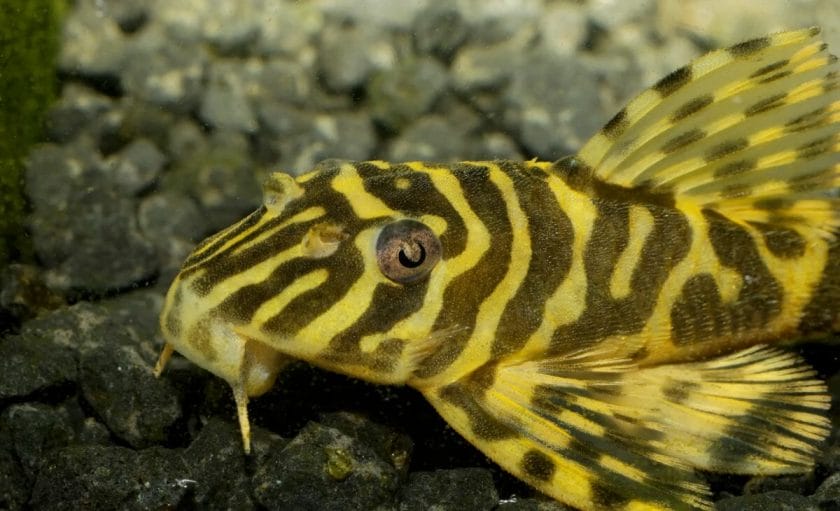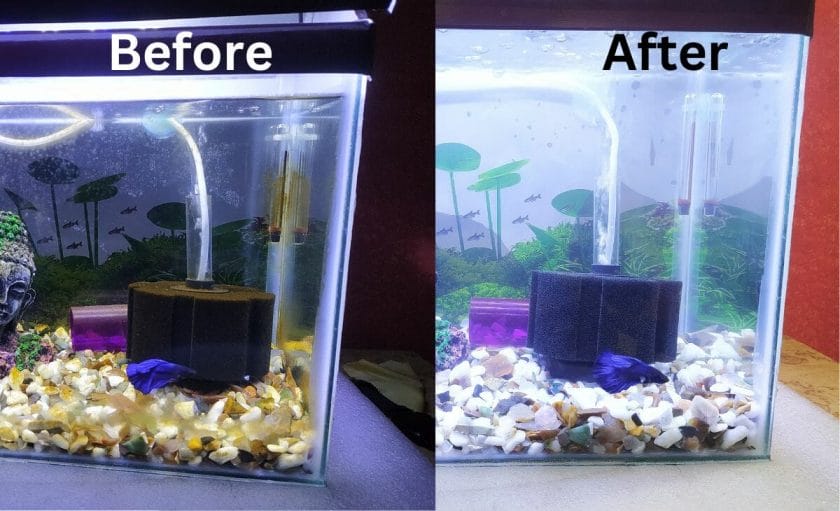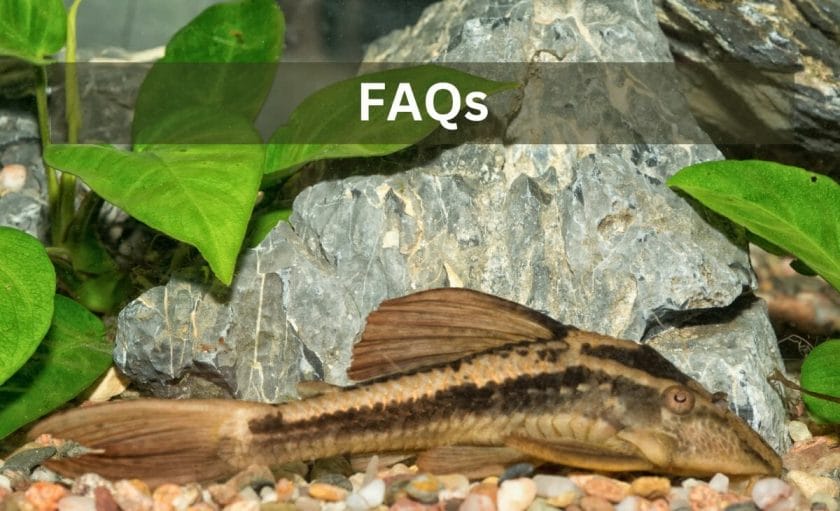Catfish are a popular aquarium choice for keeping tanks clean, but most aquarists don’t understand what these armored fish can and cannot do. What can catfish do to keep a tank clean, and are they any good at dealing with algae?
Many species of catfish consume algae as part of their diet, some species more than others, helping to keep a tank clean; however, they will not stop the underlying cause of algae growth and should not be expected to deal with algae blooms on their own.
Catfish are often referred to as the cleaner fish of aquariums, and while that reputation is well deserved, it might be more of a misnomer than you realize.
Keep scrolling, because we’re going to dive into what these amazing fish can do. I’m also going to share some of my personal experience with catfish to give you a snapshot of their cleaning abilities.

Table of Contents
Do Catfish Get Rid of Algae?

There are some species of catfish that do eat algae. Plecos, for example, are well-known for their constant consumption of algae. The idea that catfish will clean a tank and get rid of algae by themselves, however, is entirely false.
Only some species of catfish eat algae and even those that do often do so in conjunction with other types of foods.
The Otocinclus is one example of a catfish that eats predominantly algae, helping to keep the tank clean, while Corydoras won’t eat algae at all because they are primarily carnivorous.
Put simply, the right species of catfish can help you with the aesthetics of your tank by removing unwanted slime, green film on the glass, and free-floating algae that cloud your water. Some level of algae is common in an aquarium and actually indicates good aquarium health.
It means, in essence, that the nitrogen cycle is working properly to filter waste; however, if conditions are right for an algae bloom, the algae can starve the tank of oxygen and leave your tank looking a mess.
Why Catfish Won’t Get Rid of All the Algae

Most species of catfish are opportunistic in nature, scavenging whatever is available to eat.
That doesn’t mean you should put catfish in your tank to get rid of algae; in fact, doing so might make your algae problem worse.
‘Algae’ is a broad term for many different organisms, some of which fish don’t want to eat. Black Beard algae, for example, is something that catfish (or other nibblers) usually won’t touch–not that consuming the algae would help address the underlying cause.
Again, it’s more important to focus on why the algae is taking over your tank in the first place than to add more fish—that contribute their own waste and need specific care—to the tank.
The amount of waste a fish contributes is called bioload. Snails, for example, have a very high bioload, despite the fact they love to chomp down on algae.
That means that you shouldn’t put snails in an algae-ridden tank because their bioload is only going to worsen the water quality, not improve it.
The same principle is true for catfish. They can help to remove some algae film from your tank, but they will not address the root cause of algae and contribute their own waste.
Keeping your water quality pristine with aeration, water movement, plants, and consistent water changes is much more important than adding cleaner fish.
What Catfish Eat Algae?
The fact that catfish won’t clear algae blooms shouldn’t discourage you from getting one.
While it’s important to dispel the notion that ‘catfish’ and ‘algae-eater’ are synonymous, it’s also important to define what catfish can do for your tank.
Some species of catfish, particularly plecos, do a great job of removing algae film from your plants, decorations, and tank walls.
Here are some of my personal recommendations if you want a catfish to be part of your ‘green team.’
1. Otocinclus

| Adult Size | 1 -2 inches |
| Temperature | 72 – 79 F |
| Lifespan | 3 -5 years |
| Diet | Herbivorous |
| pH | 6.8 – 7.5 |
| Minimum Tank Size | 20 gallons |
Otocinclus are the perfect algae eater, such as a fish can be named. They love to munch on algae anywhere and everywhere, but only green or brown algae.
House them in groups of at least 3 (preferably 6) or more and provide lots of hiding places for them.
2. Bristlenose Pleco

| Adult Size | 4 -5 inches |
| Temperature | 73 – 81 F |
| Lifespan | 3 -5 years |
| Diet | Omnivorous |
| pH | 5.8 – 7.8 |
| Minimum Tank Size | 30 Gallons |
Bristlenose plecos are the perfect starter catfish because they don’t get too big, are hardy in a range of tank conditions, and can help keep algae in check.
They come in brown, green, or gray colors with white or yellow spots. Any other peaceful fish is a good tankmate for the Bristlenose Pleco.
Provide a well-aerated, plant-rich environment for your plecos. Driftwood is particularly useful for plecos, since they offer a good surface for algae to grow on, thus providing the pleco with plenty of food.
3. Siamese Algae Eater

Image by aleander2137 the Creative Commons Attribution-Share Alike 4.0 International license.
| Adult Size | Up to 6 inches |
| Temperature | 75 – 79 F |
| Lifespan | Up to 10 years |
| Diet | Omnivorous |
| pH | 6.5 – 7.0 |
| Minimum Tank Size | 30 Gallons |
The Siamese Algae Eater is, as the name suggests, quite the nemesis to algae. They’re good community fish that pairs well with almost any other kind of peaceful tankmate.
They are brown in color with a distinct black stripe down the length of their body.
Keep in mind that the Siamese Algae Eater is quite picky when it comes to tank conditions, so be prepared to meet their needs if you’re investing in one of these catfish!
4. Rubber Lip Pleco

| Adult Size | 6 – 7 inches |
| Temperature | 72 – 80 F |
| Lifespan | 10 – 12 years |
| Diet | Herbivorous |
| pH | 6.5 – 8.0 |
| Minimum Tank Size | 30 Gallons |
Unlike other plecos, the Rubber Lip Pleco eats almost exclusively algae. Again, unlike other pleco species, the Rubber Lip Pleco will tackle black, blue, and brown algae under certain conditions. Just be aware that they may choose not to eat it under specific conditions.
These fish are extremely versatile with what they choose to eat; despite having a primarily herbivorous diet, some aquarists report that they’ll even munch on carnivore pellets!
Peaceful, hardy, and relaxed, provide plenty of plants (and some driftwood ideally) so that your plecos can hide and feel safe.
General Guidelines for Algae-Eating Catfish

In general, if you have a 30 gallon tank or larger, then it might be beneficial to include some catfish to add some activity in the bottom layer and keep your decorations clean.
Of course, this comes with a few caveats. While each of these 4 algae powerhouses can work wonders in your tank, they have their own care requirements.
Note, for example, that the Otocinclus has fairly strict temperature and pH preferences; they also need to be kept in groups.
Very few species of algae can eat algae and nothing else (the rubber lip pleco and the Otocinclus would be ok, but you should give them some love with a varied diet anyway). Consider their dietary preference and feed accordingly.
You can feed some delicious veggies for herbivorous or omnivorous catfish, including the following:
- Squash
- Zucchini
- Cucumber
- Carrots
- Leafy greens
Surprise, surprise: algae wafers are a great treat for algae-eating catfish such as most pleco species since they provide a concentrated food source that most other fish won’t bother with. Hikari Algae Wafers are my go-to because they sink quickly.
How to Get Rid of All the Algae

Algae can be caused by poor water quality, overfeeding, sun exposure, or other tank conditions.
Maintain Water Quality
Poor water quality is important to note here; all fish produce waste, even so-called cleaner fish. Some aquatic creatures process waste less efficiently or produce more of it, contributing to the ‘negative’ chemical elements in a tank.
If poor water quality is causing algae issues in your aquarium, then you should keep up with the regular maintenance of your fish tank to maintain the good water quality in your tank.
Avoid Overfeeding
The most common cause of algae blooms is overfeeding, so if you notice that you have an abundance of leftover food about an hour after feeding your fish, then you should greatly reduce the amount you put in.
If after an hour or so you noticed uneaten food in your tank then you should remove it using a siphon.
Avoid Direct Sunlight Exposure
You should ensure that your tank isn’t in the direct sun throughout the day. Algae need light to thrive and will tend to bloom if they get plenty of sunlight.
Create Surface Movement
Lastly, you’ll want to make sure you have enough water movement at the surface to allow adequate oxygen exchange. Low turbidity, as this is called, allows more light to penetrate the water column, again prompting the growth of algae.
Extra Steps
Catfish do serve a minor role at eating leftover food at the bottom of the tank, reducing some of the food that algae would otherwise feed on, but you shouldn’t ever get catfish solely for the purpose of cleaning your tank. If anything, they will only exacerbate the problem.
If you’ve got the root cause of algae under control but still want to take some steps to clean your tank, then my personal recommendation is the Jasonwell Magnetic Algae Scrubber to supplement your catfish cleaning. It’s safe, easy-to-use, and readily wipes off algae from the glass without you needing to get your hands wet!
You might also consider using an algae scraper or, even simpler, a piece of kitchen towel and rubbing the glass yourself. Of course, never use any kind of harsh chemicals or surfactants inside your tank for cleaning because they can seriously harm your fish.
FAQs

Do You Need to Feed Catfish Anything Besides Algae?
Catfish can be carnivorous, omnivorous, herbivorous, or predominantly algae-eating. Most species of catfish are bottom feeders and will opportunistically eat whatever comes their way, but it’s certainly worth doing some research to ensure your catfish are eating the right diet!
Are Catfish Good for Beginner Tanks?
Catfish are good for beginner tanks. They may attack slow-moving, bottom-dwelling fish, but many species can be amicable and suited for smaller tanks, although not usually smaller than 30 gallons. Cories are the perfect catfish for beginners because they’re hardy, peaceful, and adorable.
How Do I Keep My Fish Tank Bottom Clean?
Siphon your tank regularly, gently hovering and occasionally plunging the gravel, substrate, or sand. Doing so helps you remove algae film and fish waste. You can also occasionally remove decorations from the tank and wash them under running water (check carefully for hidden fish first).
Conclusion
Catfish do a wonderful job of cleaning algae, depending on the species and the type of algae, but they’re not a one-fish cleaning station.
Some species of catfish, like the Otocinclus, will devour as much algae as they can, but regardless of the species, you need to address the underlying cause if you are experiencing problems with algae.
Catfish can be part of your tank cleaning crew, but if you’re dealing with recurring algae, then it’s likely there’s another tank health problem that needs addressing.
Make sure to pay attention to the helpful information provided above to find the right catfish for your tank and tackle algae problems as they arise!
If you want to keep catfish in your tank, as most of them can grow pretty large, usually you need a large tank to keep them (30 gallons or more). But there are some small species of catfish that are suitable for smaller tanks. You can check them out here.